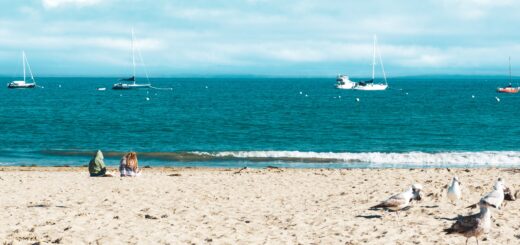Kayaking Elkhorn Slough
For one of our last field trips of the semester, I took my Coastal Field Studies class kayaking in Elkhorn Slough!
The slough is a tidal estuary—meaning that it connects to the ocean and is impacted by tides moving in and out. There are many species using the slough waters and surrounding lands including harbor seals, southern sea otters, California sea lions, 300+ species of birds, and many others.
One of the topics of the course is historic and modern human impacts on coastal ecosystems. Elkhorn Slough is a perfect place to learn about, and view, a multitude of impacts spanning nearly two centuries.
In addition to a long history of use by many groups of people, nearby lands were drained for agriculture, the Moss Landing Power Plant dominates the view, and in the 1950s and 1960s the Moss Landing Harbor was built. Today, there are many projects to restore and conserve both aquatic and terrestrial habitats around the slough.
Getting Ready!
After arriving at Monterey Bay Kayaks, the staff fitted the group for equipment. Some students opted for splash jackets and wetsuit pants, while others went with just the required life jacket. Everyone paired up and we headed to a little sandy beach near the boat launch ramp.
Most of my students had little to no kayaking experience, so we got an introduction to paddling and practiced basic some moves on the beach. As the pairs launched kayaks into the water, we paddled around a sandbar that is exposed at low tide. Dozens of California brown pelicans were hanging out on the sandbar, giving my students their first up-close wildlife experience of the day.

Since we were a large group, Monterey By Kayaks provided 3 naturalist guides. They expertly organized the 15 kayaks into a floating “raft” while pointing out the natural and human-made features of the slough. There was the main boat channel and harbor, a narrow strip of sandy dunes protecting the slough from the open ocean, and of course, the main slough.
The main portion of the slough is protected and is not open to motorized boats….perfect for calm water and excellent wildlife viewing!

More Wildlife Awaits!
We made our way across the boat channel and under the highway bridge to the main estuary. Before we even made it out of the boat channel, we saw a California sea lion and at least a dozen sea birds!
Floating on its back, the sea lion rested with fins pointed out of the water. They do this to catch extra sunlight and warm up in the chilly water. It’s called thermoregulation.
Brandt’s cormorants flew back and forth to the top of some harbor markers bringing grasses and other material to build nests. This time of year they have bright blue throats, and are quite a sight.
The bridge pylons were covered with anemones and other creatures that you might normally find in a tidepool. With the low tide, some of the anemones hung above the waterline drying out in the morning breeze.

But there were still two species that everyone wanted to see…harbor seals and southern sea otters. And my students were not disappointed! Harbor seals slept the morning away on a little strip of sandy shoreline. And nearby, sea otters attended to pups, ate a snack, and chased away birds—and another group of kayakers—who got too close.
While fuzzy and cute looking, sea otters are actually fairly aggressive. Especially when they have pups. If you look closely, many adults have scars on their noses from fighting with each other.
The Return Trip!
As we watched the otters, jellyfish, and birds, the foggy morning gave way to sunny skies. The tide also reversed direction and started to flow into the slough. This was our que to begin heading back.
The old Moss Landing Power Plant outflow structure created calm spot to take a break. Paddling back against the constant flow of the incoming tide was hard work! At one point, the power plant was one of the largest in California. Today the site continues to house a natural gas electrical generation power plant and two battery storage facilities.
Nearing our starting point, a lone harbor seal lazily followed us, occasionally popping its head out of the water to eye the kayaks.
By the time we returned to the little beach where we had launched the kayaks, the tide had risen enough to cover the sandbar in a few inches of water. The pelicans and gulls were still there, but looked a bit disturbed.
We Want to See More!
By the time we made it back to land and brought back all our gear, everyone was ready for lunch! Our kayak adventure may have been over, but the excited talk of seeing so many species in real life told me that this endeavor was a total success.
While groups of students piled into their cars for the short drive to local restaurants, five students headed back out onto the water…. “We want to see more!”
If you’re ever in central coastal California, I highly recommend a paddle around Elkhorn Slough with the folks at Monterey Bay Kayaks.
If you’re interested in seeing some more pictures from this trip and learning about some of the species my students saw, head over to my post “Elkhorn Slough Photographs.”
And be sure to check out my next post to hear what experts have to say about hands-on learning experiences for college students—including field trips!




